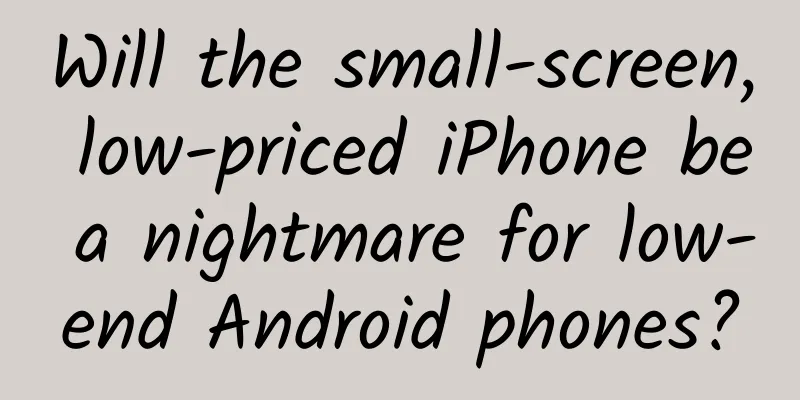Will the small-screen, low-priced iPhone be a nightmare for low-end Android phones?

|
Not long ago, rumors about Apple launching a 4-inch small-screen phone in 2015 attracted the attention of the industry. Now there are more details about the rumors about Apple's 4-inch screen. For example, the phone is named iPhone6S mini. According to reports from Taiwanese media, in mid-2015, Apple will stop producing iPhone 5c to pave the way for iPhone6S mini. The 4-inch screen phone will complete the unfinished mission of iPhone5C, that is, to cover the low-end and mid-range user groups. What has attracted the most public attention is that the contract price of iPhone6 mini may be as low as 150~100 US dollars. Of course, Apple has not officially responded to the launch of iPhone6S mini 4-inch screen or its price. iPhone6 mini may target the low-end and mid-range market. What does this mean for Android phones? We know that although the design of the iPhone 6 released by Apple this year has been criticized by the industry, it is undeniable that when the iPhone 6 was officially launched, the sales figures proved the irresistible charm of Apple. There is a consensus that the iPhone 6 plus is very popular in the Asian market. It was once in short supply due to production capacity issues. There is no doubt that the launch of the iPhone 6 plus intercepted and weakened the advantages of Samsung's high-end large-screen mobile phones. And overall, it also relatively weakened the competitiveness of large-screen high-end mobile phones such as Sony, HTC, LG, and Huawei. In addition, we know that in the US market, the sales volume of iPhone 6 is about three times that of Plus. Large screens are not popular among European and American users. The author mentioned in a previous article: "European and American users pay more attention to the grip, one-handed operation, aesthetics, and convenience of smartphones. European and American users' cities, traffic environment, cultural factors, and mobile phone usage scenarios are more inclined to small-screen phones." Based on the needs of users in Europe and the United States, Apple's re-launch of 4-inch small-screen phones can better please European and American users and effectively consolidate the Apple fan user group in Europe and the United States. The 4-inch screen is necessary for Apple's ecological layout to connect everything There has always been a lack of a high-end small-screen mobile phone in the Android camp. This has also formed a perception among Android users that high-end Android phones must have large screens. According to industry rumors, based on the price of $100 to $150, Apple's 4-inch screen is mainly in the mid-to-low-end. However, an overlooked fact is that the Android camp has always lacked high-end small-screen mobile phones that can compete with it. In fact, the key to the problem is the pricing of iPhone6s mini. The industry pointed out that the price of iPhone6S mini is 100~150 US dollars. Whether this price is true or not cannot be confirmed, but it is obvious that Apple's 4-inch screen is going to hit the low-end market. Because it has always positioned itself as a luxury mobile phone brand, Apple has not been able to get down to the high-end niche market, but whether it is CarPlay that connects to cars, Homekit that connects to homes, or Apple Pay that is to be promoted on a large scale, it requires a large number of users. High-end means niche, and niche conflicts and contradictions with Apple's ambition to connect everything. How to resolve this contradiction of maintaining a high-end brand tone and encircling a large number of users? Based on the rhetoric of responding to the needs of European and American users for small-screen operating habits, it may be a better solution to make the 4-inch small-screen mobile phone exist as a special and independent brand. The real gap between Android and Apple lies in the software ecosystem built under the operating system. Apple's ecological chain is jointly maintained by OSXi and iOS, App Store, iTunes, Safari, iWork, iMessage and other operating systems and system core software, as well as iCloud, Phone, iPad, iPod, Mac, etc., and a complete ecosystem is built through the collaboration and deep integration of software and hardware. From the perspective of Android, although everyone is talking about the concept of ecology, such as Xiaomi, and Xiaomi's current software ecology is built on the Android customized system MIUI, but on the PC side or smart hardware side, Xiaomi currently does not have a corresponding unique operating system to achieve a complete deep integration and ecological collaboration with the mobile side. Although Google can improve the shortcomings of the Android system, the advantages of the collaborative ecology and deep integration of software and hardware are the heights that Google cannot reach at present, which is also the biggest shortcoming and shortcoming of Android manufacturers at present. As mentioned above, the launch of the 4-inch screen is to replace the iPhone 5C to complete the historical mission of attracting Android mid-to-low-end market users. However, the iPhone 5C does not support Apple NFC payment and does not have fingerprint unlocking. These can be achieved on Apple's 4-inch screen. Apple also wants to integrate banks, merchants, operators, and mobile phone companies into its own NFC camp through NFC payment. The new 4-inch screen to replace the iPhone 5C can effectively attract Android mid-to-low-end users to popularize Apple Pay. For this phone, Apple's payment-specific chip, NFC function, and Health sports and health software are integrated, and the iOS ecosystem continues to expand to the Android mid-to-low-end user group. Android international giants are in decline, Apple can't find a rival even with binoculars We know that although Samsung has the advantage of a horizontally integrated hardware supply chain, its mobile terminal business has been declining for three consecutive quarters this year, and it has begun to give in to Apple, for example, Samsung has begun to manufacture for Apple. According to the Financial Times, Samsung Electronics recently officially closed the Samsung Experience Store, the flagship store in London, UK. This move was interpreted as a sign that Samsung has begun to gradually give up challenging Apple's dominance. Sony has been losing money for almost seven consecutive years, and Motorola's share of the global smartphone market is only 2%. BlackBerry's share of the global smartphone market is less than 1%. Domestic mobile phones have copied the low-end back road through the cost-effective strategy of low price and high configuration, but they have been absent in the core technology of software and hardware. For example, Huawei is the only domestic manufacturer with independent chips, and at the operating system level, it is all dependent on the Android system. In terms of superior software layout and independent operating system, it is almost the short board of all domestic manufacturers. Undoubtedly, if Apple wants to return to 4 inches, it is targeting this point. Although there is almost no difference between Android and iOS in terms of hardware, at the operating system level, Android's fragmentation, software and system compatibility issues, freezes, frequent pop-up ads, malicious programs, various loopholes and defects caused by customized systems, and other user experiences are still far behind the ease of use and smoothness of Apple's closed iOS system. Many users admit that iOS is Apple's trump card, and they switch from Android to Apple more based on the iOS system. Back to the previous topic, the international giants of the Android camp have almost completely declined. As mentioned earlier, there has always been a lack of a high-end small-screen mobile phone in the Android camp. In fact, this is also the original sin caused by the full opening of Android mobile phones to industry chain developers. An industry insider once pointed out: "The open industry chain and development environment determine that Android cannot control and optimize various mobile phone hardware, so the small space cannot be equipped with more powerful chips, and it will also limit the size and battery capacity." Apple's closed system of integrated hardware and software can relatively handle the size, appearance, hardware configuration and software compatibility. This means that after Apple launches its 4-inch screen, the Android camp may lack models with equally small screens to compete with it. Judging from Apple's own historical process, Apple has become mediocre due to its lack of innovation. However, compared with the chaos of mobile phone manufacturers in the Android camp, mediocre Apple has taken more than 80% of the profits from smartphones, and the advantages of its integrated hardware and software ecological layout are constantly deepening. It is even unable to find any rivals even with a telescope. Will the 4-inch screen be a nightmare for Anroid’s low-end phones? At present, the screen size of Samsung GalaxyS5 mini and Sony Xperia Z3 Compact are both 4.6 inches, and the industry believes that they are competing models of iPhone 6S mini. But as mentioned above, if the price difference is not big, it is not difficult to imagine how users will choose from the perspective of iOS system usability and Apple brand premium. From the analysis, we can know that Apple has been criticized this year and it is also true that it lacks innovation, but the giants of international Android mobile phone manufacturers are facing a comprehensive decline. In addition, domestic manufacturers have been hovering in the middle and low end for a long time. Due to the lack of strong competitors and subversive forces to pry open the Apple ecosystem, the mediocre Apple has ushered in a heyday where no rivals can be found even with binoculars. The future may still be about domestic mobile phones. Although domestic mobile phones seem to be in a good position, one thing that must be acknowledged is that the huge user demand and incremental space in the domestic low-end mobile phone market are the objective market conditions for the development and rise of domestic mobile phones. If they compete with Apple, they have no advantages in terms of software and hardware. The only remaining advantage is price and cost performance. Then the problem is simple. Apple's 4-inch screen mobile phone will impact the low-end market. The first to bear the brunt must be Xiaomi and China Cool Alliance. Even in the entire Android camp's low-end mobile phone market, there is no low-end brand and cost performance advantage to compete with it. However, the risk for Apple is that launching a 4-inch screen and low-priced iPhone involves a trade-off between Apple's market share and brand appeal. If it is not differentiated and positioned from Apple's mainstream iPhone brand, it may weaken or reduce Apple's high-end brand premium. In the long run, making a fuss about screen size or appearance design cannot support Apple's future. Its genes determine that innovation is the fundamental driving force for Apple to continue to shine in the market. But in the short term, the key to Apple's return to 4 inches is pricing. If the 4-inch iPhone 6S mini, which includes Apple's NFC payment and fingerprint unlocking, and the iOS software ecosystem, is used at an unimaginably low price to occupy the Android users, the mid- and low-end Android phones in the future may lose their competitiveness. This is a revelation to domestic mobile phone manufacturers: without core technology advantages in hardware such as chips, cameras, sensors, CPUs and screens, and lacking soft power and control over the global supply chain in system software such as operating systems, blindly competing on cost-effectiveness, sentimentality, and fan economy is just avoiding the important issues, and it will not constitute core competitiveness. If the price advantage of mid- and low-end Android phones relative to Apple disappears, it may be a nightmare for all Android phone manufacturers. As a winner of Toutiao's Qingyun Plan and Baijiahao's Bai+ Plan, the 2019 Baidu Digital Author of the Year, the Baijiahao's Most Popular Author in the Technology Field, the 2019 Sogou Technology and Culture Author, and the 2021 Baijiahao Quarterly Influential Creator, he has won many awards, including the 2013 Sohu Best Industry Media Person, the 2015 China New Media Entrepreneurship Competition Beijing Third Place, the 2015 Guangmang Experience Award, the 2015 China New Media Entrepreneurship Competition Finals Third Place, and the 2018 Baidu Dynamic Annual Powerful Celebrity. |
<<: WeChat enters the deep waters of monetization: the focus this year may be advertising
>>: Why has mobile payment not become popular after so many years?
Recommend
What is the difference between a 9.9 yuan headset and a 1,000 yuan headset?
One minute with the doctor, the postures are cons...
A law takes Google News out of Spain
On December 11, the Spanish legislature recently ...
How to create a strong live streaming personality that can sell products?
In the field of live streaming sales on Douyin, i...
Durex's confession copywriting this time is absolutely amazing
Durex is so advanced this time. On May 20th, Dure...
Mr. Murong's BOLL indicator technical tactics
Introduction to Mr. Murong's BOLL indicator t...
How much does it cost to develop a community convenience service mini program and a community group buying mini program?
With the continuous development of mobile Interne...
Taichi jailbreak v1.2.0 released to crack iOS 8.1.2 in half a day
This morning, Apple officially released iOS8.1.2 ...
This high-calcium, nutritious wild vegetable is recommended to be eaten in early spring! Unfortunately, many people treat it as a grass...
In spring, everything comes back to life, and all...
ZUK Z2 Pro won nine world firsts. Yang Yuanqing: I made the most correct decision
Yesterday, Jia Yueting just released LeEco's ...
Surface 2 to be released on September 23 with 1080p screen
[September 9 news] Microsoft has sent out invitat...
What are the ways to promote Xiaohongshu?
When it comes to Xiaohongshu’s promotion methods,...
How to attract traffic on Weibo? Precise traffic generation techniques on Weibo!
In this era, many people are scrambling to gather...
A universal method to improve operations and marketing conversion rates!
Previously, I shared that my favorite growth is r...
How much does it cost to invest in Zigong tableware mini program?
How much does it cost to attract investment for t...
Attention all travelers! Be sure to share this health tip with your family
The Spring Festival holiday is over, and the chil...









